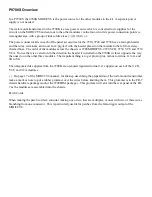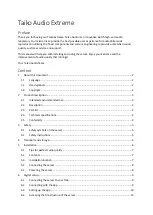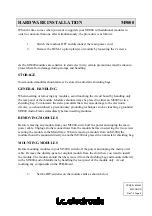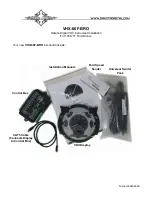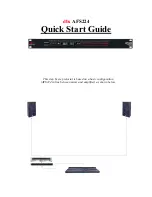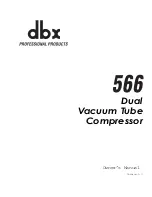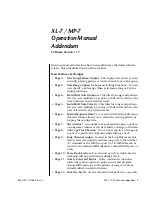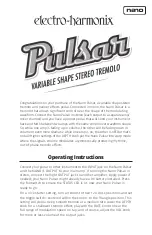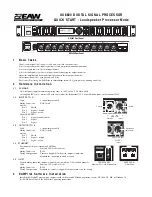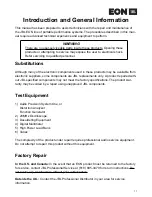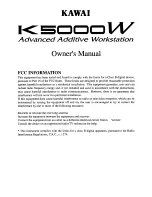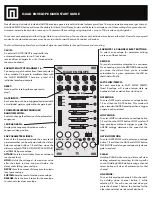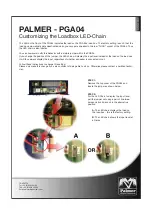
MIDI2CV8 Pitch CV and VCO Scaling Adjustment
(procedural supplement)
Assert Low-key Transpose for 0V Pitch CV from the keyboard controller low key (reference the MIDI2CV8 kit
manual insert). This is the default, or automatic action with v3.0 firmware.
The DAC Tune trim is first set by connecting the pitch cv output to a multitester set to measure dc volts in a 0-
10V range and then pressing octave spaced keys on the connected MIDI controller while adjusting the trim for
1V changes.
Later the VCO will be adjusted with this calibrated MIDI2CV8 output.
While a tuner can be useful, it can throw you off if the input is overloaded, clipping the wave and introducing
harmonics. It is only necessary to hear octaves as the adjustments are made.
The VCA L and R sections can be used to mix the VCO A and B and the output from the VCA L + R output for
monitoring.
Begin with the setting for a linear, volt/octave pitch CV from the MIDI2CV8. A dvm can be used to check that
octave spaced key presses are outputting a 1V pitch cv change (down to a hundredth of a volt or so) as set by the
trim on the MIDI2CV8. The most accurate setting will be obtained if you press octaves that start a few notes
above the lowest key, ie if your low key is a C, press D or higher for the lowest octave reading.
The usual tuned setting for the VCO scale trims is about a 1:00 setting for the pointer of the disk which covers a
cw range from about 7:00 (ccw) to 5:00 (cw). Start with the trim at 1 o'clock.
After having been powered for a minute or two patch the pitch CV over to the VCOA P2 input. Set the two
pitch controls so they are both in-tune at unison at about a mid-rotation setting for the low key pressed on the
controller. Play an octave higher and readjust the A panel pitch control for an octave relationship with B. Go
back to the low note and adjust the A Scale trim control for unison and then, again, press an octave higher and
adjust the A panel Pitch control for an octave relationship with B. After going back and forth like this another
time or two, you should find the scale is about as close as is possible. Then, do this all again pressing some note
a few keys higher than the lowest key (with VCO B adjusted to match at this new low pitch) and confirm/tweak
the scale to match for higher pressed octave relationships with B (using the A Scale trim to realign A with B after
adjusting the A panel Pitch control). When the A Scale adjustment is complete, move the pitch control voltage
over to VCO B P2 and make the panel Pitch and B Scale trim adjustments to get unison and octaves referencing
the pitch of VCO A.
After the B Scale trim is set, move the Pitch CV over to the VCOA P1 input and listen to the two vcos tracking
across the keyboard range after aligning their pitch while a higher note is pressed, say the third or fourth octave.
Confirm they track as you press keys going down towards the low key. You should be able to turn up the sound
of the controller or some other MIDI Sound Module and hear that the tones made from the VCOs can be aligned
using the panel pitch controls and follow as you play different ranges on the keyboard (make the alignment
between the two when a key pressed in the middle C to A 440 range is pressed--its easier to hear the beating
slow as they are tuned).

